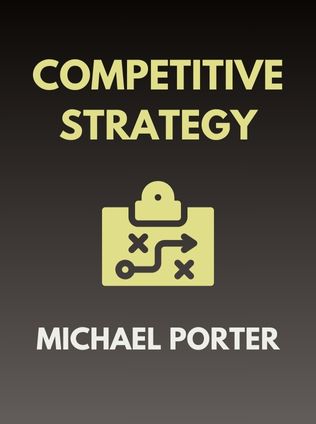
Competitive Strategy
Techniques for Analyzing Industries and Competitors
By Michael Porter
Published 10/1980
About the Author
Michael E. Porter, a prominent economist, professor, and authority on competitive strategy, is best known for his groundbreaking work in the field of strategic management. As a professor at Harvard Business School, Porter has influenced generations of business leaders and scholars. His work, particularly Competitive Strategy, has redefined how organizations approach competition, making it essential reading for anyone involved in business strategy.
Porter’s approach to competitive strategy is rooted in his deep understanding of economics and business dynamics. Over the years, he has developed numerous theories, including the well-known Five Forces framework, which is central to understanding competition in any industry. His insights are not just academic but also practical, guiding businesses to achieve sustainable competitive advantages.
His other significant contributions include his theories on competitive advantage, clusters, and the value chain. These concepts have become foundational in strategic management courses worldwide. Porter’s ability to blend theory with actionable insights has cemented his reputation as a thought leader in business strategy.
Main Idea
In Competitive Strategy, Porter provides a comprehensive framework for understanding and mastering the complexities of competitive environments. The book introduces key concepts that help businesses analyze their competitive landscape, understand their competitors, and craft strategies to outperform them. Porter's main idea is that businesses must not only understand the factors shaping their industry but also develop strategies that leverage their strengths to exploit these factors effectively.
At the heart of the book is the notion that competitive advantage stems from a company’s ability to cope with and influence the competitive forces in its industry. Porter argues that by understanding these forces, companies can position themselves in ways that capitalize on their strengths while mitigating their weaknesses. The book is structured into three main parts: understanding the factors that shape a market, analyzing competitors' strategies, and determining your competitive strategy.
Table of Contents
- Understanding the Factors That Shape Your Market
- Analyzing Your Competitors’ Strategies
- Determining Your Competitive Strategy
Understanding the Factors That Shape Your Market
The first step in developing a competitive strategy is to understand the environment in which your business operates. Porter identifies five key forces that shape every market and industry. These forces determine the intensity of competition and the profitability of the market. They are:
- Supplier Influence
- Buyer Influence
- New Competitors
- Alternative Offers
- Rivalry Competitiveness
Supplier Influence
Supplier influence is the power that suppliers have over the pricing, quality, and availability of materials. When suppliers hold significant influence, they can dictate terms that may limit a company's competitiveness and profitability. For example, in the diamond industry, a few large mining companies exert control over the market by setting prices and restricting supply.
"Suppliers that can dictate prices, quality standards, and availability create a bottleneck for competition." - Michael Porter
Several conditions enhance supplier influence, including the absence of substitute goods, the dependence of larger or more profitable markets on these suppliers, and the high costs associated with switching suppliers. To counter this influence, companies might explore alternatives such as integrating key production processes in-house or forming strategic partnerships.
Buyer Influence
Buyers can exert considerable influence over businesses by dictating prices, demanding higher quality, or opting for alternative products. The more options buyers have, the more power they wield. For instance, in the smartphone market, buyers have many brands to choose from, which forces companies to compete aggressively on price and features.
Sign up for FREE and get access to 1,400+ books summaries.
You May Also Like
Rich Dad Poor Dad
What the Rich Teach Their Kids About Money - That the Poor and Middle Class Do Not!
By Robert T. KiyosakiFreakonomics
A Rogue Economist Explores the Hidden Side of Everything
By Steven D. Levitt and Stephen J. DubnerThe Lean Startup
How Today's Entrepreneurs Use Continuous Innovation to Create Radically Successful Businesses
By Eric RiesWho Moved My Cheese?
An Amazing Way to Deal with Change in Your Work and in Your Life
By Spencer Johnson, M.D.Factfulness
Ten Reasons We're Wrong About the World – and Why Things Are Better Than You Think
By Hans RoslingMake Your Bed
Little Things That Can Change Your Life...And Maybe the World
By William H. McRaven



















